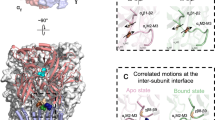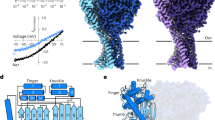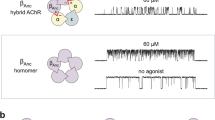Abstract
Transmitter-gated cation channels are detectors of excitatory chemical signals at synapses in the nervous system1. Here we show that structurally distinct α3β4 nicotinic and P2X2 channels influence each other when co-activated. The activation of one channel type affects distinct kinetic and conductance states of the other, and co-activation results in non-additive responses owing to inhibition of both channel types. State-dependent inhibition of nicotinic channels is revealed most clearly with mutant P2X2 channels, and inhibition is decreased at lower densities of channel expression. In synaptically coupled myenteric neurons, nicotinic fast excitatory postsynaptic currents are occluded during activation of endogenously co-expressed P2X channels. Our data provide a molecular basis and a synaptic context for cross-inhibition between transmitter-gated channels.
This is a preview of subscription content, access via your institution
Access options
Subscribe to this journal
Receive 51 print issues and online access
$199.00 per year
only $3.90 per issue
Buy this article
- Purchase on Springer Link
- Instant access to full article PDF
Prices may be subject to local taxes which are calculated during checkout





Similar content being viewed by others
References
Green, T., Heinemann, S. F. & Gusella, J. F. Molecular neurobiology and genetics: investigation of neural function and dysfunction. Neuron 20, 427–444 (1998).
Rogers, M., Colquhoun, L. M., Patrick, J. W. & Dani, J. A. Calcium flux through predominantly independent purinergic ATP and nicotinic acetylcholine receptors. J. Neurophysiol. 77, 1407–1417 (1997).
Fieber, L. A. & Adams, D. J. Adenosine triphosphate-evoked currents in cultured neurones dissociated from rat parasympathetic cardiac ganglia. J. Physiol. (Lond.) 434, 239– 256 (1991).
Fieber, L. A. & Adams, D. J. Acetylcholine-evoked currents in cultured neurones dissociated from rat parasympathetic cardiac ganglia. J. Physiol. (Lond.) 434, 215–237 (1991).
Nakazawa, K. ATP-activated current and its interaction with acetylcholine-activated current in rat sympathetic neurons. J. Neurosci. 14, 740–750 (1994).
Searl, T. J., Redman, R. S. & Silinsky, E. M. Mutual occlusion of P2X ATP receptors and nicotinic receptors on sympathetic neurons of the guinea-pig. J. Physiol. (Lond.) 510, 783–791 ( 1998).
Zhou, X. & Galligan, J. J. Non-additive interaction between nicotinic cholinergic and P2X purine receptors in guinea-pig enteric neurons in culture. J. Physiol. (Lond.) 513, 685 –697 (1998).
Barajas-Lopez, C., Espinosa-Luna, R. & Zhu, Y. Functional interactions between nicotinic and P2X channels in short-term cultures of guinea-pig submucosal neurons. J. Physiol. (Lond.) 513, 671–683 ( 1998).
Collo, G. et al. Cloning of P2X5 and P2X6 receptors and the distribution and properties of an extended family of ATP-gated ion channels. J. Neurosci. 16, 2495–2507 (1996).
Zhou, X. & Galligan, J. J. P2X purinoceptors in cultured myenteric neurons of guinea-pig small intestine. J. Physiol. (Lond.) 496, 719–729 ( 1996).
Brake, A. J., Wagenbach, M. J. & Julius, D. New structural motif for ligand-gated ion channels defined by an ionotropic ATP receptor. Nature 371, 519–523 (1994).
Xu, W. et al. Megacystis, mydriasis, and ion channel defect in mice lacking the alpha3 neuronal nicotinic acetylcholine receptor. Proc. Natl Acad. Sci. USA 96, 5746–5751 ( 1999).
Xu, W. et al. Multiorgan autonomic dysfunction in mice lacking the β2 and β4 subunits of neuronal acetylcholine receptors. J. Neurosci. 19, 9298–9305 (1999).
Labarca, C. et al. Channel gating governed symmetrically by conserved leucine residues in the M2 domain of nicotinic receptors. Nature 376, 514–516 (1995).
Evans, R. J. et al. Ionic permeability of, and divalent cation effects on, two ATP-gated cation channels (P2X receptors) expressed in mammalian cells. J. Physiol. (Lond.) 497, 413–422 (1996).
Figl, A., Labarca, C., Davidson, N., Lester, H. A. & Cohen, B. N. Voltage-jump relaxation kinetics for wild-type and chimeric beta subunits of neuronal nicotinic receptors. J. Gen. Physiol. 107, 369– 379 (1996).
Khakh, B., Bao, X., Labarca, C. & Lester, H. Neuronal P2X receptor-transmitter-gated cation channels change their ion selectivity in seconds. Nature Neurosci. 2, 322–330 ( 1999).
Virginio, C., MacKenzie, A., Rassendren, F. A., North, R. A. & Surprenant, A. Pore dilation of neuronal P2X receptor channels. Nature Neurosci. 2, 315 –321 (1999).
Taleb, O. & Betz, H. Expression of the human glycine receptor alpha 1 subunit in Xenopus oocytes: apparent affinities of agonists increase at high receptor density. EMBO J. 13, 1318–1324 (1994).
Honore, E. et al. Different types of K+ channel current are generated by different levels of a single mRNA. EMBO J 11, 2465 –2471 (1992).
Duke, T. A. & Bray, D. Heightened sensitivity of a lattice of membrane receptors. Proc. Natl Acad. Sci. USA 96 , 10104–10108 (1999).
Boue-Grabot, E., Archambault, V. & Seguela, P. A protein kinase C site highly conserved in P2X subunits controls the desensitization kinetics of P2X(2) ATP-gated channels. J. Biol. Chem. 275, 10190–10195 (2000).
Lutz, P. L. & Kabler, S. Release of adenosine and ATP in the brain of the freshwater turtle (Trachemys scripta) during long-term anoxia. Brain Res. 769, 281– 286 (1997).
Bueno, L. & Fioramonti, J. Can. J. Gastroenterol. 13, 42A–46A (1999).
Miyazawa, A., Fujiyoshi, Y., Stowell, M. & Unwin, N. Nicotinic acetylcholine receptor at 4.6 A resolution: transverse tunnels in the channel wall. J. Mol. Biol. 288, 765 –786 (1999).
Liu, F. et al. Direct protein–protein coupling enables cross-talk between dopamine D5 and γ-aminobutyric acid A receptors. Nature 403, 274–280 (2000).
North, R. A. Families of ion channels with two hydrophobic segments. Curr. Opin. Cell Biol. 8, 474–483 (1996).
Acknowledgements
Thanks to H. Li for assistance with preparation of oocytes, and to other members of the group for comments. A Wellcome Trust (UK) International Prize Travelling Fellowship (to B.S.K.) and the NIH supported this work.
Author information
Authors and Affiliations
Corresponding author
Rights and permissions
About this article
Cite this article
Khakh, B., Zhou, X., Sydes, J. et al. State-dependent cross-inhibition between transmitter-gated cation channels . Nature 406, 405–410 (2000). https://doi.org/10.1038/35019066
Received:
Accepted:
Issue Date:
DOI: https://doi.org/10.1038/35019066
This article is cited by
-
The ASIC3/P2X3 cognate receptor is a pain-relevant and ligand-gated cationic channel
Nature Communications (2018)
-
ATP from synaptic terminals and astrocytes regulates NMDA receptors and synaptic plasticity through PSD-95 multi-protein complex
Scientific Reports (2016)
-
Summation of GABA- and Glutamate-Mediated Ion Currents in Isolated Rat Cerebral Cortex Neurons
Neuroscience and Behavioral Physiology (2014)
-
Mitochondrial dysfunctions in Myalgic Encephalomyelitis / chronic fatigue syndrome explained by activated immuno-inflammatory, oxidative and nitrosative stress pathways
Metabolic Brain Disease (2014)
-
P2X4 receptor regulation of transient receptor potential melastatin type 6 (TRPM6) Mg2+ channels
Pflügers Archiv - European Journal of Physiology (2014)
Comments
By submitting a comment you agree to abide by our Terms and Community Guidelines. If you find something abusive or that does not comply with our terms or guidelines please flag it as inappropriate.



